Average Numbers for National Baseball Hall of Famers: Catchers
- John Butler
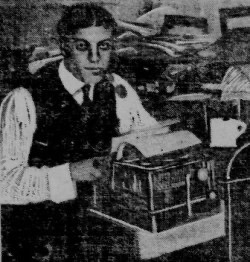
- Mar 18, 2022
- 7 min read
Updated: Mar 21, 2022
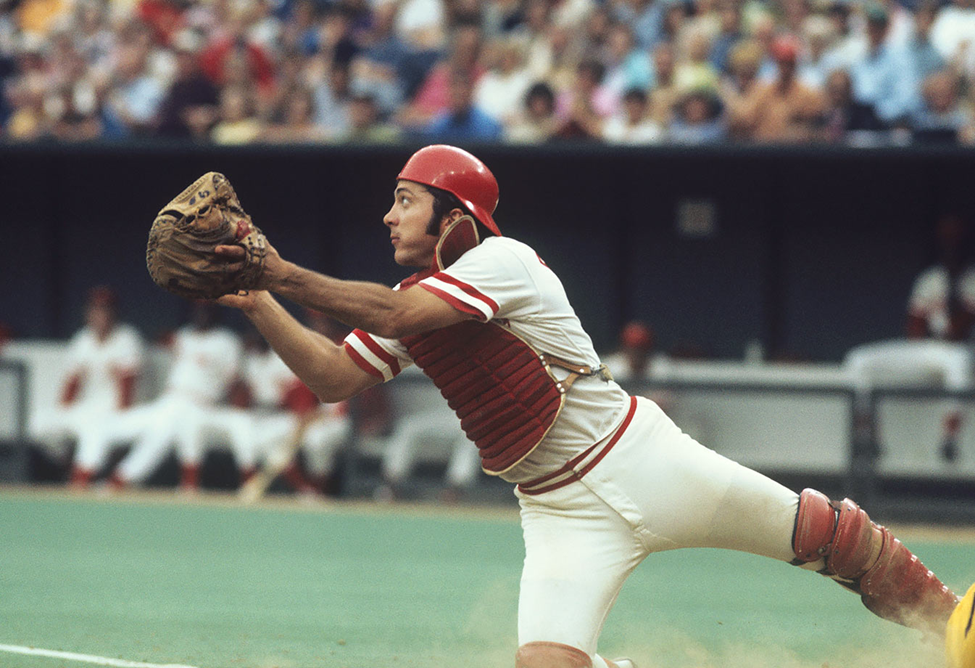
Johnny Bench was inducted into the Baseball Hall of Fame in 1989 after a storied 17-year career with the Cincinnati Reds with his name on 431/447 ballots for 96.4% which is still the highest by a catcher. Bench got in alongside legendary Boston Red Sox leftfielder Carl Yastrzemski and outstanding competitor Gaylord Perry. Photo by brennanpekelder.
Jack Butler
Catcher is the hardest position in baseball as backstops have to sit in a crouch position for an entire 9-inning game, block pitches in the dirt, throw out runners attempting to steal a base while calling the game for his pitcher. Those are the catcher’s duties in the field, but they also provide an important role with the bat. However, that wasn’t always the case for the first 56 years of Major League Baseball until Mickey Cochrane debuted for Connie Mack’s Philadelphia Athletics in 1925 to become one of the first power hitting catchers. Cochrane retired with 1652 hits, 119 HR, 830 RBI, and a .320 batting average. When he was inducted into the Hall, Cochrane had the highest batting mark, most homers, and hits by a catcher. Those numbers would be surpassed by Bill Dickey and Gabby Hartnett who were enshrined in 1954 and 1955 respectively.
Yogi Berra and Roy Campanella each shined in the 1950s where they won 3 league MVPs apiece. From Berra’s enshrinement in 1972 to 1981, he held the home run record by a Hall of Fame catcher with 358 until Johnny Bench passed him and finished with 389. The 1970s launched a new era for catchers with Bench claiming 2 NL MVPs in 1970 and 72, Carlton Fisk became an All-Star with the Boston Red Sox, and Gary Carter was a talented young backstop with the Montreal Expos. Each catcher compiled at least 2000 hits, 300 home runs, 1200 RBI, and a .260 batting average. After those guys retired, Mike Piazza and Iván Rodríguez were the top two catchers in baseball in the 1990s where one historically excelled at the plate while the other is arguably the greatest defensive catcher. When Piazza and Rodríguez called it careers, Joe Mauer became the game’s best catcher while Buster Poster established himself as the young talent at the position. Mauer won 3 AL Batting Titles over a 4-year period from 2006-2009 and the 2009 AL MVP while Posey took home the 2012 NL MVP and 3 World Series Championship with the San Francisco Giants. These two will have their first year on the writers’ ballot in 2024 and 2027.
Now that we’ve established how challenging the position is and its evolution over baseball 153-year history, it’s time to look at the average numbers for the 19 Hall of Fame catchers. Beginning with WAR, the average is 48.2 which is the lowest out of the 10 positions as rightfield has the highest at 70.6. However, my data includes the 3 catchers who played in the Negro Leagues – Josh Gibson, Biz Mackey, and Louis Santop – which is a 10.2% decrease from Baseball Reference’s 53.7 WAR. Those 3 played in less games putting up fewer counting stats than their MLB counterparts in Cooperstown but still need to be celebrated. Moving to games and games caught, the average stands at 1713 games and 1461 games caught for a % of games caught at 84%. There was a discrepancy of games caught on Baseball Reference as Standard Fielding would show one number and Appearances another. Thus, for the data collected used the number from appearances which goes for the other 7 positions going forward.
Continuing with defensive metrics, according to a JoeBlogs article titled “dWAR to end all WARs,” defensive WAR is a “number that estimates how much value above replacement level a player brings with his defense” (2017). Rodríguez leads Hall of Fame catchers with a 29.6 dWAR with the late Gary Carter in second with a 26.1 dWAR. Louis Santop has the lowest dWAR at 0.2 but he only played in 115 games over a 4-year career in the Negro Leagues so the actual low belongs to Mickey Cochrane’s atrocious 0.7 dWAR over 13 seasons.
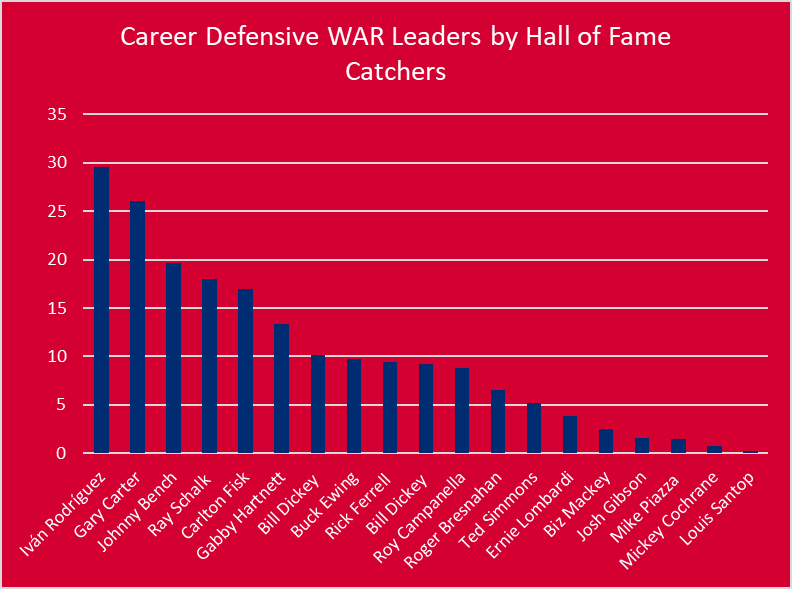
Looking at the career dWAR leaders by Hall of Fame catchers, only 7 members have a dWAR over 10.2 which includes Iván Rodríguez Gary Carter, Johnny Bench, Ray Schalk, Carlton Fisk, Gabby Hartnett, and Bill Dicky. Graph by Jack Butler.
Next is the Gold Glove Award – first awarded in 1957 in the Major League only – to the outstanding fielder at each position every year which sometimes is a popularity contest when looking at Derek Jeter winning 5 with horrible defensive sabermetrics and Rafael Palmeiro winning when he only played 28 games at 1B and 128 games as a DH. Nevertheless, of the top 11 on the all-time Gold Glove list by catchers contains only two Hall of Famers with Rodríguez’s record 13 and Bench won 10 while Yadier Molina has the most by an active player with 9. Molina will most likely be enshrined into Cooperstown in 2028 as he is a 10-time All-Star, 4-time Platinum Gold Glove Award winner, has 2 World Series rings, and a Silver Slugger in 2013 along with 2112 hits, 171 home runs, 998 RBI with a career .280/.330/.402 slash line.

A total of 46 players from the American and National League have won a Gold Glove Award but only 11 have won 4 or more which consists of Iván Rodríguez, Johnny Bench, Yadier Molina, Bob Boone, Jim Sundberg, Bill Freehan, Del Crandall, Charles Johnson, Mike Matheny, and Tony Peña. 3 are on the battery-mates list that have appeared in more than 200 starts together since 1914 – Molina with Adam Wainwright for 300 and counting, Crandall with Hall of Famer Warren Spahn for 316, and Freehan with Mickey Lolich for a record 324 games. Graph by Jack Butler.
Moving to the offensive side where we’ll analyze the catcher’s production with the bat. The average Hall of Fame catcher averaged 6686 plate appearances and 5926 which is the lowest mark of any position, and it might have to do with catchers regularly batting 8th to focus on defense that according FanGraphs would give them 3.90 PA/GS or 2.84 PA/G with subs (Douglas, 2017). 10 Cooperstown members exceeded both averages with Mickey Cochrane, Ray Schalk, and Ernie Lombardi just missing it by a couple hundred PAs and ABs. Runs was at 868 with it being reached by 6 of the past 8 inducted for an average of 927 runs which is a 6.80% increase from the original average. The average for hits is 1719 which is the lowest output by a position and is the only one to not reach at least 2000 hits where more than half the catchers reached the mark. The doubles mark is 304 – the least of any position and 51 triples that was exceed by 6 of the first 9 members and just 2 of past 10. Regarding the long ball, the catchers averaged 200 home runs to be right in middle of other positions and is at the 50th percentile. All 19 catchers averaged to drive in 988 which is the only position to not drive in 1,000 or more.
Even with low hitting averages in basic counting stats among the catchers, Yogi Berra, Johnny Bench, Carlton Fisk, Gary Garter, Mike Piazza, and Iván Rodríguez were sluggers who redefined the position. These 6 are the only Hall of Fame backstops with at least 2000 H, 300 HR, and 1200 RBI with the most hits, home runs, and RBI belonging to Rodríguez, Piazza, and Bench at 2844, 427, and 1430, respectively. 4 of the 6 players won at least 3 Silver Sluggers except for Berra and Bench as the award wasn’t introduced until 1980 as the Yankee great had long retired and Bench’s numbers started to decline. A different group of 4 had four or more seasons with 20 HR and 100 RBI with Bench and Piazza each having 6 a piece while Fisk and Rodríguez combined for just 3.

These 6 Hall of Fame catchers are the only ones to exceed 2000 H, 300 HR, and 1200 RBI in a career. They combined for 80 All-Star appearances, 26 Gold Gloves, 25 Silver Sluggers, 14 World Series Championships, 6 MVPs, 3 Rookie of the Years, and 3 AS MVPs. Graph by Jack Butler.
Now for the average slash line for Hall of Fame catchers, .296/.368/.466 and if you add the on-base percentage and slugging percentage you get a on-base plus slugging of .834. Surprisingly it’s not the worst as shortstops take that honor with a .291/.360/.411 and a .711 OPS. Piazza has some of the best numbers with a .308 BA, .377 OBP, .545 SLG, and a .922 OPS while Gibson’s .374/.458/.719 and a 1.177 OPS is even more impressive. The last stat to be looked at is the OPS+ sabermetric.
OPS+ is a sabermetric that’s an extension of OPS that accounts a player’s on-base plus slugging percentage and normalizes across the whole league which is measured to see how elite a batter is. The Hall of Fame catchers average is 126 OPS+ that was met by 12 members who combined for a 136 OPS+ – 36 percent above the league average of 100 – while the other 7 averaged a 111 OPS+, just 11 percentage better than league average.
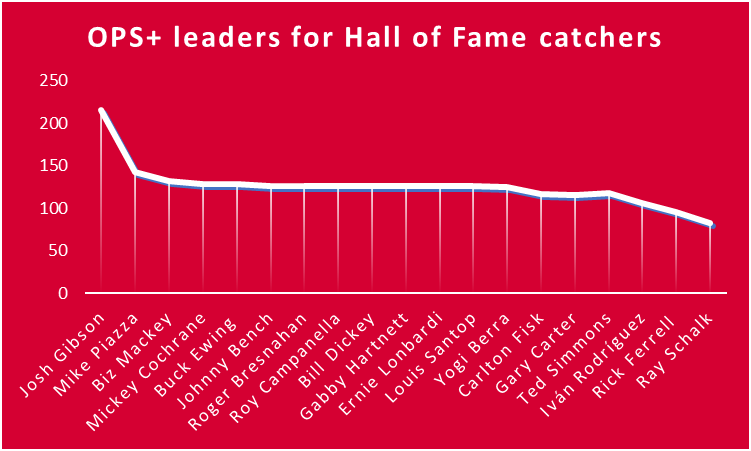
OPS+ is an advanced statistic a measure how elite a hitter is, and Josh Gibson and Mike Piazza have the first and second-best career OPS+ at 215 and 143 respectively. Rick Ferrell and Ray Schalk have the worst OPS+ of a 95 and 83. Graph by Jack Butler.
The catcher is a difficult position to analyze for future inductees as its emphasis on defense first and offense second is becoming more prevalent again and gone are the days of backstops consistently hitting 20 HR and driving in 100 each season. Yadier Molina seems like a lock for me while Joe Mauer has the awards and stats, but injuries derailed a lengthy career and is 1500 hits, 158 HR, 729 RBI enough for Buster Posey for enshrinement? Only time will tell but I believe that the catchers should be looked at in the area that they played in.
Sources
Baseball Reference. (2022). Retrieved March 17, 2022, https://www.baseball-reference.com/
Doug. (January 28, 2016). High Heat Stats. Retrieved March 17, 2022, from "200 Game Batteries."
Posnanski, Joe. (November 16, 2017). JoeBlogs. Retrieved March 17, 2022, from https://joeposnanski.substack.com/p/dwar-to-end-all-wars?s=r






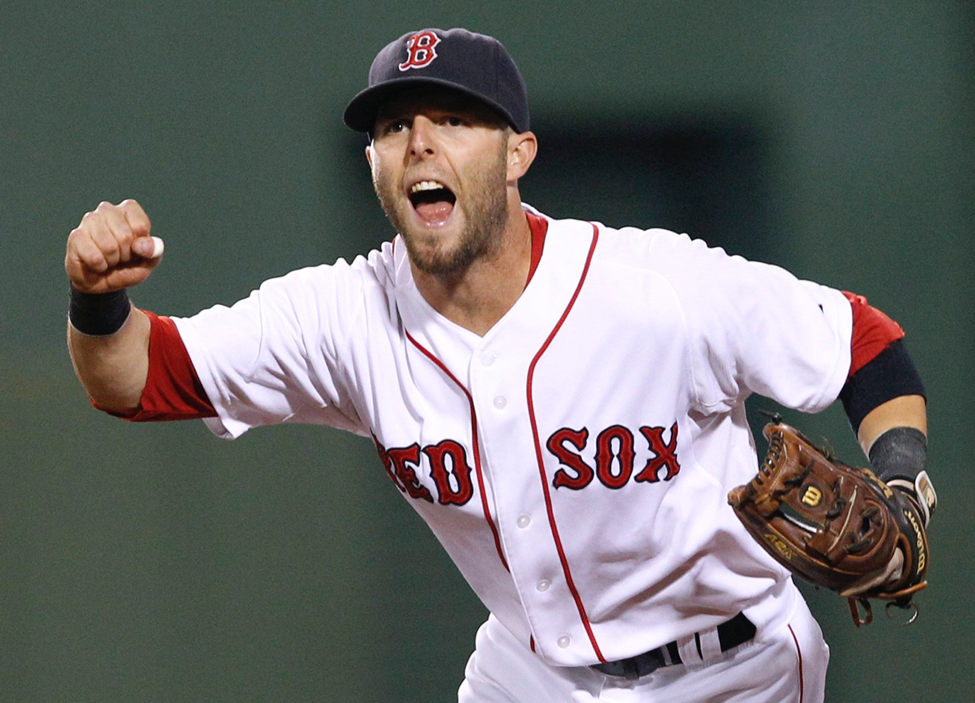
Comments